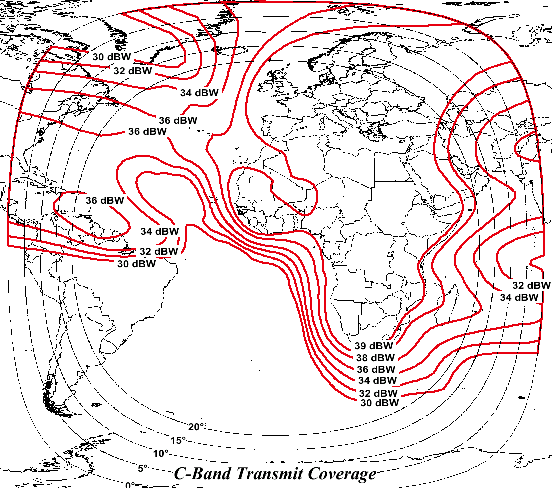C-band MSG-1 EUMETCast service.
Following the failure of an SSPA on MSG-1 and the decision not to disseminate data directly via this satellite (see details elsewhere) EUMETSAT were unable to provide the usual 'global beam' data coverage adopted by geostationary meteorological satellites.
Europe had been catered for regarding MSG dissemination with the Ku-band service of EUMETCast but this was only receivable in Europe.
EUMETSAT had an obligation to supply African States with MSG meteorological data under the EU funded PUMA Agreement, which had equipped African States with MSG receiving stations. EUMETSAT looked to C-band for a global type footprint that would give good coverage of Africa. This they found on the new EUTELSAT Atlantic Bird-3 satellite - part of the 'Atlantic Gateway' location of EUTELSAT stationed at 5° W. Tests were carried out uplinking DVB EUMETCast by the Fucino ground station to Atlantic Bird-3 and reception of the data via a C-band transponder downlink.
The tests were successful and EUMETSAT announced the go-ahead for the service with trial reception beginning around October 2003 and the service is now operational and called EUMETCast-Africa.
The C-band beam used covers the whole of Europe and Africa, all of which, with the exception of parts of Morocco, southern Algeria, Mali and Niger, lie within the 39 dBW footprint - see diagram below.
The format of the C-band dissemination is the same as for the Hot Bird-6 Ku-Band dissemination - DVB EUMETCast. The data is uplinked to Atlantic Bird-3 via the Fucino ground station in Italy and is a selected re-broadcast of the Hot Bird EUMETCast Ku-band service.
EUMETSAT document EUM TD 15 includes details of both the C-band EUMETCast service as well as the Ku-band dissemination of MSG-2 data and the recommended system requirements for both services.
South America had always been in the global footprint of Meteosat's first generation satellites services and would have been with MSG until the SSPA problem intervened.
EUMETSAT extended the C-band service to cover South and Central America and most of N. America via New Horizons satellite NSS-806 with a service called EUMETCast-Americas.
These services are part of the expanding GEONETCast global service.
Access to the C-band EUMETCast service within and wihout EUMETSAT Member States is subject to applications using EUMETCast's On-Line Registration.
T-Systems tq®-TELLICAST software and an EKU are required plus software to deal with file management and image display, such as David Taylor's MSG Data Manager. Details on the EUMETCast Overview page.
EUMETSAT state that the tq®-TELLICAST software runs under Linux as well as Windows.
| Satellite | EUTELSAT Atlantic Bird 3 at 5° W |
| Transponder | C02 |
| Downlink Frequency | 3726.7535 MHz |
| Downlink Polarisation | Circular Left Hand |
| Symbol Rate | 5.964 Msymbol/s |
| FEC | Auto |
However, the Atlantic Bird-3 C-band footprint over Europe and Africa is only 39 dBW compared to Hot Bird-6's [Ku-band] spot beam of 53 dBW over SE England and central Europe, therefore much larger dishes will be required to receive this service.
EUMETSAT recommend a 2.4 m dish for reception of the C-Band service within the central contours of the Europe/Africa footprint.
The Atlantic Bird-3 C-band EUMETCast footprint extends into the eastern part of the US at reduced levels and EUMETSAT recommend that a dish size of 3.7 m will be required in most US locations.

Footprint diagram for Atlantic Bird-3 C-band transmission.
